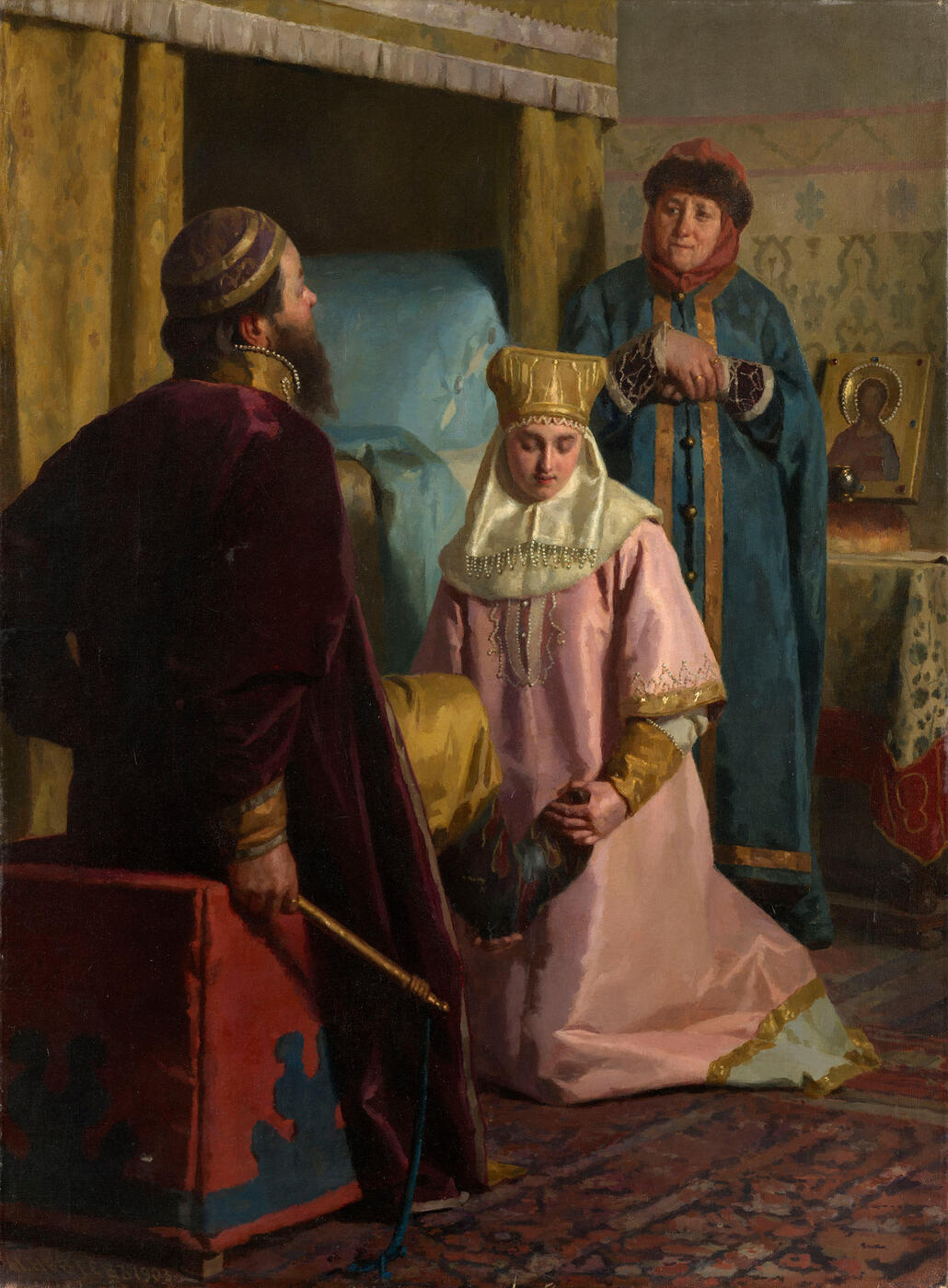28 Nov 2018 Important Russian Art Auctions, at Asia House
28 November 2018

* 64. NEVREV, NIKOLAI (1830-1904)
What Kept the Bonds of Marriage Strong, signed and dated 1903.
Oil on canvas, 100.5 by 75 cm.
120,000-180,000 GBP
Provenance: Acquired by the father of a previous owner in Moscow in 1927.
Important Russian Pictures, Christie’s London, 30 November 2004, lot 91.
Private collection, Europe.
Authenticity of the work has been confirmed by the expert V. Petrov.
Authenticity has also been confirmed by the expert T. Goriacheva.
Exhibited: XXXII Peredvizhnaia vystavka Tovarishchestva peredvizhnykh khudozhestvennykh vystavok, Moscow, St Petersburg, 1904, No. 162.
Literature: Niva, No. 16, 1904, p. 305, illustrated in black and white.
Katalog XXXII vystavki Tovarishchestva peredvizhnykh khudozhestvennykh vystavok, Moscow, 1904, p. 10, No. 162, listed; p. XIII, No. 162, illustrated in black and white.
R. Danovskaia, Ocherki po istorii russkoi zhivopisi vtoroi poloviny XIX veka. N.V. Nevrev, Moscow, State Tretyakov Gallery, 1950, pp. 44–45, mentioned in the text.
G. Romanov, Tovarishchestvo peredvizhnykh khudozhestvennykh vystavok. 1871–1923 g.g. Entsiklopediia, St Petersburg, Sankt-Peterburg Orkestr, 2003, p. 285, No. 3–237, illustrated and listed.
V. Artemov (ed.), Nikolai Nevrev, Moscow, Belyi Gorod, 2004, pp. 44–45, mentioned in the text.
The present lot as mentioned in the 1950 publication The picture by the prominent genre artist Nikolai Nevrev What Kept the Bonds of Marriage Strong is his last extensive work dealing with customs and traditions in Old Russia. The artist first tackled such period scenes on the advice of the archaeologist Alexei Uvarov, who was also passionate about Russia’s cultural history, and following the announcement in the early 1870s of a competition for the best picture on a subject from Russia’s history to mark the opening of the Historical Museum in Moscow. Later, Nevrev was to become an acknowledged master of the genre. He was particularly fond of portraying the hardships of women in patriarchal Russia before Peter the Great, which lived according to the canons of a strictly disciplined family life. He would also quite frequently handle this same theme in his compositions on the most burning issues of the day, which were given an enthusiastic reception by his progressive contemporaries and critics.
When condemning his own times for the lack of rights suffered by girls married off for the sake of gain, the sale of pretty peasant women, and the unhappy lot of domestic servant girls and poor female relatives, Nevrev was counting primarily on the biting social criticism that was so popular at the Peredvizhniki (Itinerant) exhibitions. At the same time as he addressed historical issues, the artist could allow himself to focus on the search for the individual beauty of the scene, the costumes and the whole milieu altogether, only assigning to the “gender issue” the role of the initial compositional idea. More often than not, in his historical pictures, he would look to the 16th century, to the age of Ivan the Terrible and to subjects from the history of the reign of Boris Godunov and Peter I (Vasilisa Melentievna and Ivan the Terrible; Boris Godunov Examines Pictures Sent from England of Possible Brides; The Tsar’s Bride; Princess Praskovia Yusupova before Taking her Monastic Vows; Marina Mnishek in Moscow Prison; etc.).
The picture What Kept the Bonds of Marriage Strong was painted by Nevrev in 1903 and immediately became one of the highlights at the 32nd Itinerant Exhibition, held in Moscow and St Petersburg. A reviewer at the magazine Niva describes its subject as follows: “What kept the bonds of marriage strong? The question is answered by Nikolai Nevrev’s curious picture, which depicts a scene from Russian married life in the pre-Petrine era. The newlyweds – husband and wife – have only just been married, and now, after the wedding feast, the husband demonstrates his power over his wife, as was the custom: she takes off his boots, thereby showing her devotion and obedience to his will, while he, holding that ‘power’ [i.e. a whip] in his hand, must gently and courteously teach her with that ‘power’… In olden times, family life was often maintained by this patriarchal practice.” (Niva, No. 16, 1904, p. 310).
The critics did not approve of Nevrev’s enthusiasm for the historical genre, taking the view that he sacrificed genuine artistic content in order to meticulously depict the splendid costumes and magnificently painted household effects. Collectors, though, set a high value on the varied range of the artist’s interests, and his works, similar to the one presented for auction, entered the collections of the eminent Muscovites Pavel Tretyakov, Savva Mamontov and Ivan Tsvetkov, as well as Bogdan Khanenko and Ivan Tereshchenko in Kiev, and nowadays are shown at exhibitions in major museums in Russia and the former Soviet republics.
Notes on symbols:
* Indicates 5% Import Duty Charge applies.
Ω Indicates 20% Import Duty Charge applies.
§ Indicates Artist's Resale Right applies.
† Indicates Standard VAT scheme applies, and the rate of 20% VAT will be charged on both hammer price and premium.